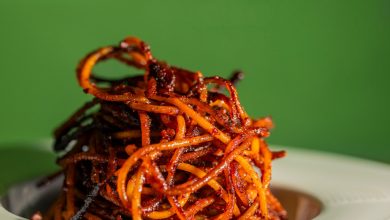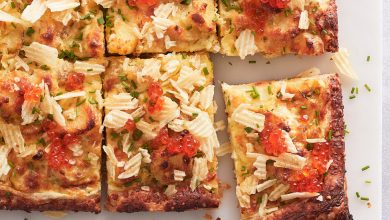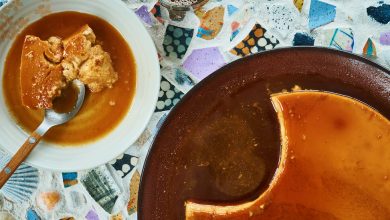What a Big Menu You Have, Grandmother

In kitchen mythology, no archetype is more potent than the grandmother, and most powerful of all is the nonna. Even if you’re not Italian, you probably have an idea how the archetypal Italian grandmother looks and, more to the point, how she cooks.
Pick a major cooking website and you can look up recipes for Nonna’s meatballs, Nonna’s gnocchi, Nonna’s minestrone, Nonna’s cutlets, Nonna’s brodo, Nonna’s tiramisù, on and on, made by an army of nonnas brandishing wooden spoons, rolling pins and rosemary branches. You have to wonder what these women could have done if they’d been let out of the kitchen.
Restaurants have leveraged the nonna factor in their marketing. Some slap the word on a dish made with a recipe from the chef’s grandmother. On Staten Island, Enoteca Maria supplements a fairly routine Italian American menu with several dishes each night from a rotating cast of nonnas. Italy supplied them all at first, but for the past few years the kitchen has welcomed grandmothers from other countries, like Nonna Kathy from Uzbekistan and Nonna Pauline from Trinidad.

Addolorata Marzovilla, known as Nonna Dora, is back in the kitchen after an effort at retirement. “She hated it,” her son said.Credit…Evan Sung for The New York Times
But few places have taken grandma branding as far as Nonna Dora’s Pasta Bar. There is a real Dora, whose legal name is Addolorata Marzovilla, and she is a real nonna, born 86 years ago in Apulia. The pasta is hers, rolled out and shaped by her hands in a glass-box workshop inside the dining room. The pasta bar itself is hers, too. She opened it in February in the Kips Bay neighborhood of Manhattan, the first business she has owned after making pasta for more than 30 years in restaurants owned by her son, Nicola.
The last and longest-running of these, I Trulli, closed for good last year. Ms. Marzovilla did not take well to retirement, apparently.
“She hated it,” her son said one night while stopping by my table to suggest a bottle of Chianti. “I had to build her this restaurant so she’d have something to do.”
When Ms. Marzovilla gets restless, my best advice is to get hungry. She makes around 20 kinds of pasta a day — 40 batches total, if you include each variety’s gluten-free option. Some are rarely seen in New York. One is scarcely known outside Apulia, where the Marzovillas originated: ceci e tria, chickpeas tossed with both boiled noodles and fried ones, rolled into small crisp golden tubes that look something like empty cannoli. A theory about ceci e tria, more formally ciceri e tria, holds that the fried strips of dough were meant to make up for the taste of meat, which few Apulian families could afford. My own guess is that the dish was invented by a restless nonna driven to heights of ingenuity by too many nights of plain pasta with chickpeas.
A better-known product of hard times in Apulia is grano arso flour, ground from charred grains of wheat scavenged from the fields after the stalks have been cut and burned to the ground. Ms. Marzovilla kneads the flour into long, slender tubes of maccheroncini, then pits their bread-crust flavor against sweet peas and tender strands of duck confit.
The standards are here, too. The chewy black strands of Nonna Dora’s spaghetti neri keep their squiggles and kinks after they’re dressed with bottarga butter and toasted bread crumbs. Translucently thin pappardelle are tangled up with wild boar ragù in a broth that has just enough tomato to give it the color of a terra-cotta planter. Cannelloni, in delicate green sheets, don’t quite contain the filling that spills out onto the plate — ricotta whipped with burrata to a creaminess that suggests fior di latte gelato if you could somehow heat it without melting it.
I could complain that the cavatelli seem heavy and dull, but I suspect that has less to do with the pasta itself than with its topping: chopped broccoli rabe and almonds that don’t quite add up to a sauce.
Besides placing Ms. Marzovilla’s skill at center stage, turning pasta into the main event makes Nonna Dora’s feel more in tune with the way people eat now than I Trulli did. Those hunks of meat and fish that tend to be the least interesting part of a traditional Italian meal no matter how good they are have been kicked off the menu. The idea of secondi lives on in the form of large platters for two or more — bistecca Fiorentina, zuppa di pesce — that must be ordered a day in advance.
But the focus is on the stuff most of us go to Italian restaurants for. A night at Nonna Dora’s could start with velvety pink mortadella or salty-sweet culatello, and maybe some crystalline lumps of two-year-old Parmigiano-Reggiano.
Dried fava beans cooked and mashed with dandelion leaves — fave e cicoria — may not sound as appealing as a charcuterie platter, but I could probably eat it once a week. I will not be revisiting the so-called octopus salad — a salad with a not-so-tender octopus leg laid over the top. Strips of fried squid spilling out of a waxed-paper sack are fun even if the marinara you’re supposed to dip them in is a bit thin. The kitchen must save the best part of the sauce for the baked eggplant, as pure and convincing a case for the pleasures of Southern Italy as you could want.
You eat all this either at high-top tables squeezed in alongside Ms. Marzovilla’s glass lair or at a stool along a long counter that faces the stove at the far end and shelves of arcane liquor at the other. When you picture a grandmother in the kitchen, the scene might include a small glass of wine discreetly tucked behind the flour canister. You don’t necessarily envision a first-rate cocktail bar, but Nonna Dora’s has one.
Many drinkers will see the Negroni section on the menu’s first page, a growing list with 11 at last count, and decide to work their way through the whole bunch. (Negroni Tre has a stiff backbone of evergreens, while Negroni Cinque summons up a forager’s basket of wild herbs.)
This is a fine response, but the plot thickens on the next page. At top are the Aviation, the Last Word and other classics; the bottom is given over to tiki drinks. Both categories are hip-deep in Italian spirits; the idea behind the tiki tribute was the observation that Italians are behind a number of great rums, including the Capovilla sugar-cane rhum that goes into the anise-scented pineapple punch called the Frangipane.
As you try to keep the Frangipane’s mint sprig and paper umbrella out of your eyes, you may look around and notice that the most conspicuous thing missing from dinner at Nonna Dora’s Pasta Bar is Nonna Dora herself. Her workshop, so productive by day, is mostly used at night for plating desserts. Ms. Marzovilla, presumably, is home, gathering strength to make the next day’s orrecchiete (in a rabbit ragù that’s bright with tomatoes) and ribbed, saffron-tinted malloreddus (shiny with a tomato-sausage sauce).
Who can begrudge her a few hours off her feet? At the same time, I can’t help hoping that her restaurant will start to serve lunch, and that when it does, she’ll be at her post, pressing dough over her thumb to put the dimples in those orrecchiete.
Follow New York Times Cooking on Instagram, Facebook, YouTube, TikTok and Pinterest. Get regular updates from New York Times Cooking, with recipe suggestions, cooking tips and shopping advice.





